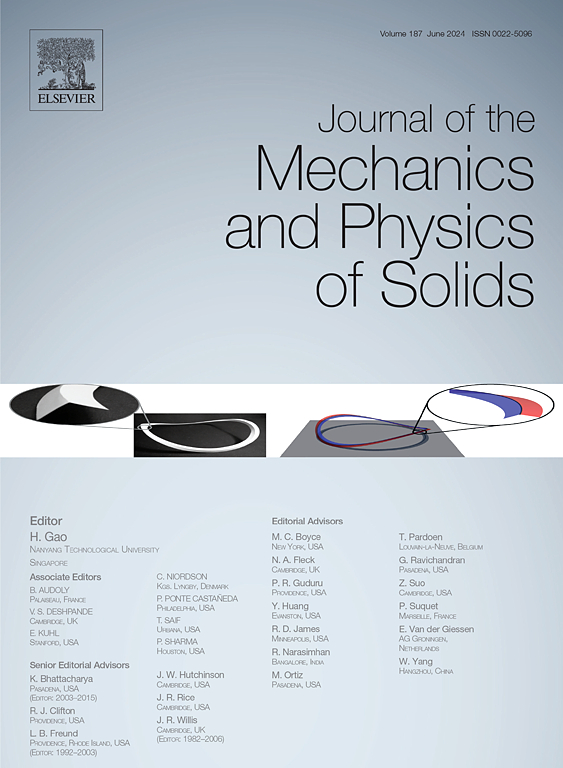具有马蹄形微结构的对缺陷不敏感的柔性随机网络材料
IF 5
2区 工程技术
Q2 MATERIALS SCIENCE, MULTIDISCIPLINARY
引用次数: 0
摘要
近年来,具有周期性生物启发波浪状微结构的柔性网络材料备受关注,因为它们兼具低弹性模量、高拉伸性、仿生物应力-应变响应和应变限制行为等出色的机械性能。在实际应用(如生物集成设备和组织工程)中,柔性网络材料通常会战略性地设计小孔,以容纳功能芯片和其他独立电子元件。因此,设计对缺陷不敏感的柔性网络材料至关重要。虽然随机结构构造被认为在许多生物材料的优异机械性能中发挥了关键作用,但随机性对柔性网络材料机械性能的影响尚未被探索。本文介绍了一类由马蹄形微结构组成的二维(2D)柔性随机网络材料。它们的节点间距分布可以用一个与随机性相关的参数来表征,并很好地遵循了 Weibull 概率密度函数。为了阐明随机性对柔性网络材料非线性机械响应的影响,我们进行了数值和实验相结合的研究。对其关键机械性能(如强度、拉伸性和初始模量)求出了简单的分析方程。研究发现,柔性随机网络材料(随机度≥ 0.4)表现出近似各向同性的 "J "形应力-应变响应,即使在高应变状态下也是如此。最后,我们研究了不同类型的缺陷(如缺少一根细丝、缺少一个节点或缺少许多细丝)对随机网络材料拉伸性和强度的影响。与周期性网络材料相比,随机网络材料(如随机度≥ 0.6)在出现缺陷时的拉伸性/强度降低幅度要小得多,因此对缺陷更不敏感。这种对缺陷不敏感的行为主要归因于随机网络材料缺陷周围的应力集中得到了缓解。本文章由计算机程序翻译,如有差异,请以英文原文为准。
Imperfection-insensitive flexible random network materials with horseshoe microstructures
Flexible network materials with periodic constructions of bioinspired wavy microstructures are of focusing interest in recent years, because they combine outstanding mechanical performances of low elastic modulus, high stretchability, biomimetic stress-strain responses, and strain-limiting behavior. In practical applications (e.g., bio-integrated devices and tissue engineering), small holes are often strategically designed in flexible network materials to accommodate functional chips and other individual electronic components. The design of imperfection insensitive flexible network materials is therefore of pivotal importance. While random structural constructions are believed to play crucial roles in the excellent mechanical properties of many biological materials, the effect of randomness on mechanical performances of flexible network materials has not yet been explored. In this work, a class of two-dimensional (2D) flexible random network materials consisting of horseshoe microstructures is introduced. Their node distance distributions, which can be characterized by a parameter related to randomness, follow well the Weibull probability density function. Combined numerical and experimental studies were performed to elucidate the effect of randomness on nonlinear mechanical responses of flexible network materials. Simple analytical equations are obtained for their key mechanical properties (e.g., strength, stretchability, and initial modulus). Flexible random network materials (with randomness ≥ 0.4) were found to exhibit approximately isotropic J-shaped stress-strain responses, even in the high-strain regime. Finally, we study the reduction of stretchability and strength in random network materials induced by different types of imperfections (e.g., a missing filament, a missing node, or many missing filaments). In comparison to periodic network materials, random network materials (e.g., with randomness ≥ 0.6) show much smaller reductions of stretchability/strength when the imperfection appears, and are therefore more imperfection-insensitive. Such an imperfection-insensitive behavior can be mainly attributed to a relieved stress concentration around the imperfection of random network materials.
求助全文
通过发布文献求助,成功后即可免费获取论文全文。
去求助
来源期刊
CiteScore
9.80
自引率
9.40%
发文量
276
审稿时长
52 days
期刊介绍:
The aim of Journal of The Mechanics and Physics of Solids is to publish research of the highest quality and of lasting significance on the mechanics of solids. The scope is broad, from fundamental concepts in mechanics to the analysis of novel phenomena and applications. Solids are interpreted broadly to include both hard and soft materials as well as natural and synthetic structures. The approach can be theoretical, experimental or computational.This research activity sits within engineering science and the allied areas of applied mathematics, materials science, bio-mechanics, applied physics, and geophysics.
The Journal was founded in 1952 by Rodney Hill, who was its Editor-in-Chief until 1968. The topics of interest to the Journal evolve with developments in the subject but its basic ethos remains the same: to publish research of the highest quality relating to the mechanics of solids. Thus, emphasis is placed on the development of fundamental concepts of mechanics and novel applications of these concepts based on theoretical, experimental or computational approaches, drawing upon the various branches of engineering science and the allied areas within applied mathematics, materials science, structural engineering, applied physics, and geophysics.
The main purpose of the Journal is to foster scientific understanding of the processes of deformation and mechanical failure of all solid materials, both technological and natural, and the connections between these processes and their underlying physical mechanisms. In this sense, the content of the Journal should reflect the current state of the discipline in analysis, experimental observation, and numerical simulation. In the interest of achieving this goal, authors are encouraged to consider the significance of their contributions for the field of mechanics and the implications of their results, in addition to describing the details of their work.

 求助内容:
求助内容: 应助结果提醒方式:
应助结果提醒方式:


